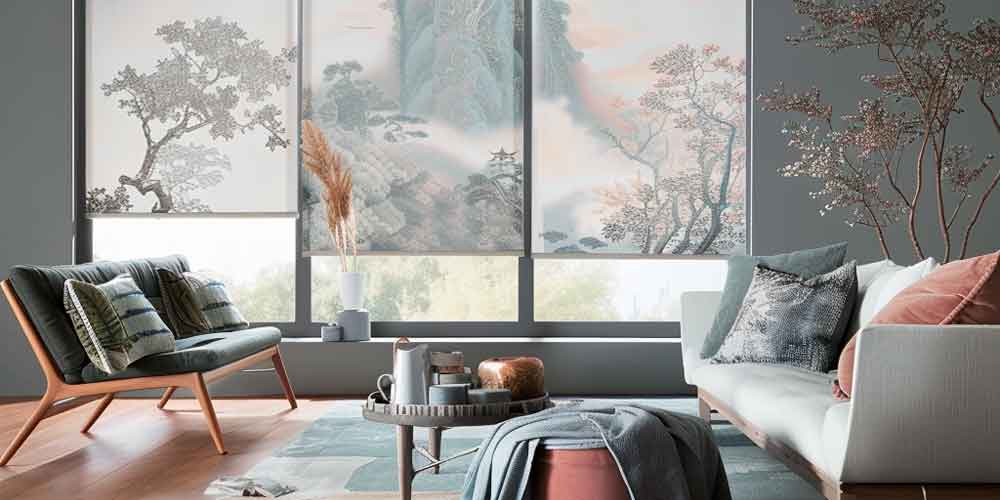Measuring & Fitting Included
Get an immediate price using our online estimator
Years’ of experience
Daytime, evening & weekend appointments
Call to speak to our call centre

Chinoiserie, a term derived from the French word “chinois” meaning Chinese, refers to the European interpretation and imitation of Chinese artistic and design elements. This artistic movement became popular in the 17th and 18th centuries and has continued to influence modern interior design. The fusion of Chinese aesthetics with Western design sensibilities has created a captivating and timeless style that adds a touch of exoticism and elegance to any space. In this article, we will explore the enduring influence of Chinoiserie in modern interior design.
Chinoiserie first emerged in Europe as a result of the increasing trade and cultural exchange between the East and the West. European explorers and traders brought back various Chinese art objects, porcelain, textiles, and other decorative items, sparking a fascination with the exotic and mysterious Chinese culture. As a response to this newfound interest, European artisans and craftsmen began incorporating Chinese motifs and techniques into their own creations.
Chinoiserie often features a colour palette inspired by Chinese landscapes and nature. Soft and muted hues, such as celadon green, powder blue, coral, and gold, are commonly used. These colours create a serene and harmonious atmosphere, reminiscent of traditional Chinese paintings.
Chinoiserie is characterized by its intricate and elaborate patterns and motifs. Some of the most popular motifs include pagodas, dragons, birds, cherry blossoms, bamboo, and willow trees. These motifs are often depicted in a stylized and ornate manner, adding a sense of drama and opulence to the design.
Chinoiserie furniture and accessories are known for their delicate and lacquered finishes. Chinese lacquerware, with its glossy and vibrant surface, became highly sought after in Europe during this period. Furniture pieces, such as cabinets, screens, and chairs, feature intricate hand-painted designs and gilded accents. Porcelain vases, figurines, and ginger jars are also commonly used as decorative objects.
Chinoiserie continues to be a significant influence in modern interior design, offering a timeless and elegant aesthetic. Here are some ways to incorporate Chinoiserie elements into your home:
One of the easiest ways to introduce Chinoiserie into your interior is through wallcoverings and wallpaper. Opt for floral or scenic wallpapers featuring Chinese-inspired motifs. These wallpapers can be used to create a statement wall or to enhance the overall ambiance of a room.
Chinoiserie-inspired furniture pieces can serve as focal points in a room. Look for lacquered cabinets, screens, or chairs with hand-painted designs. Upholstery with Chinoiserie patterns can also be used on sofas, armchairs, or throw pillows to add a touch of exoticism.
Incorporate Chinoiserie artwork and accessories to add a finishing touch to your interior. Hang Chinese landscape paintings or display porcelain vases, ginger jars, or figurines on shelves or mantels. These decorative objects can bring a sense of history and cultural richness to your space.
Chinoiserie-inspired lighting fixtures can create a captivating ambiance. Look for lantern-style pendant lights, chandeliers with delicate oriental motifs, or table lamps with painted porcelain bases. These lighting options can serve as both functional and decorative elements in a room.
Introduce Chinoiserie-inspired textiles and fabrics through curtains, draperies, or upholstery. Look for fabrics with intricate floral patterns, Chinese symbols, or bamboo motifs. These textiles can add depth and visual interest to your interior while tying together the overall Chinoiserie theme.
Chinoiserie, with its fusion of Chinese and Western design elements, has left an indelible mark on modern interior design. The incorporation of Chinoiserie elements adds a sense of exoticism, elegance, and cultural richness to any space. By embracing the intricate patterns, vibrant colours, and ornate motifs, you can create a captivating and timeless interior that pays homage to this enduring artistic movement. Let Chinoiserie inspire you to create a space that is both visually stunning and culturally significant.
1. What is Chinoiserie?
Chinoiserie refers to the European interpretation and imitation of Chinese artistic and design elements. It became popular in the 17th and 18th centuries and continues to influence modern interior design.
2. What are some common elements of Chinoiserie?
Some common elements of Chinoiserie include a colour palette inspired by Chinese landscapes, intricate patterns and motifs such as pagodas and cherry blossoms, delicate and lacquered finishes on furniture and accessories, and the use of Chinese porcelain vases and figurines as decorative objects.
3. How can Chinoiserie be incorporated into modern interior design?
Chinoiserie can be incorporated into modern interior design through the use of wallcoverings and wallpaper featuring Chinese-inspired motifs, Chinoiserie-inspired furniture pieces such as lacquered cabinets and hand-painted screens, Chinoiserie artwork and accessories like Chinese landscape paintings and porcelain vases, Chinoiserie-inspired lighting fixtures, and textiles and fabrics with intricate floral patterns or bamboo motifs.
4. What does Chinoiserie add to a space?
Chinoiserie adds a sense of exoticism, elegance, and cultural richness to a space. It creates a captivating and timeless interior that pays homage to the fusion of Chinese and Western design elements.”

With a keen eye for design Natalie is the Blinds Design Specialist at Custom Fitted Blinds. Dedicated to creating personalised solutions, she transforms spaces with creativity and expertise.
© 2024 All rights reserved
Made with ❤ with Elementor